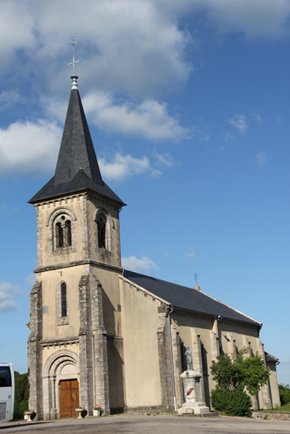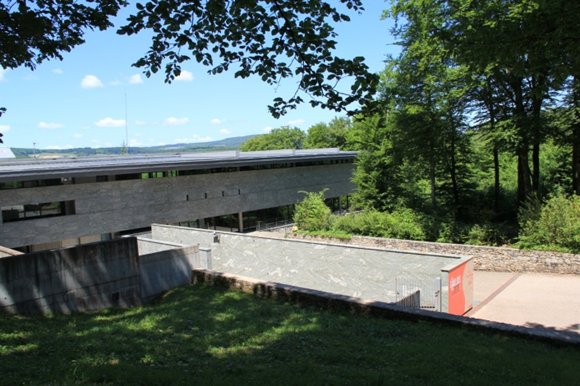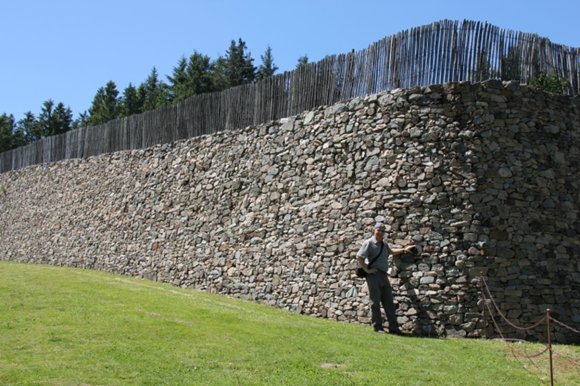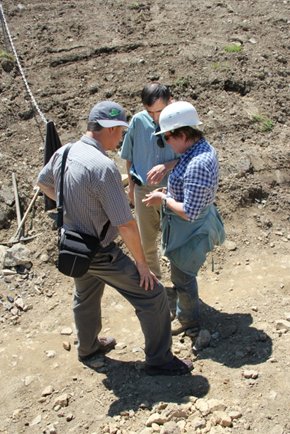Bibracte with Pascal
Posted on Jun 04, 2010 in category
Breakfast at Bibracte Residential Centre at Glux-en-Glenne is served from 7.30-8.15 making it quite a civilised starting time for archaeologists by the time they drive to the oppidum site about 5 kms away. The plan was to meet Pascal Paris, one of Bibracte’s main archaeologists, at the Museum. Pascal has volunteered to show us around Bibracte including some of the more recent excavations. Before we set out for the 5 minute drive to the museum I wanted to look at the village’s World War 1 Memorial. Incredibly, 44 young men from this small village in Burgundy were killed over the duration of the ‘Great War’. It sits prominently in front of the village’s discrete old church that still rings across the valley each morning.

Our incredible magical mystery tour with Pascal Paris was delayed until 14.00 (it was to be well worth waiting for) but this did not matter in the least as we had a two-storey Bibracte Museum to explore.
Bibracte European Archaeological Centre owes its existence to the former French President François Mitterrand. Mitterrand’s political career began in this region of Burgundy as a local mayor so a decision to built such a grand venture in 1984 in the Morvan Mountains , the former oppidum of the Celtic Eduean tribe was met with some sceptism.
Also, the fact that the European Union was looking to develop a common European interest and identity among its members seemed to assist the concept of a unifying research base into Celtic history. The project began in a bold, determined way- over 1000 hectares were bought for the project.
It’s clear to me that the Bibracte Research Centre has proven itself. It’s now a hub for all European universities to:
- Conduct on-going excavations in three year blocks with the possibility of another 3 year extension if the site proves to be productive
- train young undergraduates and postgraduates in the skills of archaeology
- provide an ongoing world-class library facility for researchers 24/7 specialising in European Celtic Studies
- educate school children about the importance of history in appreciating their present culture and general education (they set up experimental digs for them in two large pavilions-Celtic and Gallo-Roman) and of course,
- host foreign researchers like ‘moi’
The first floor of the museum took us over 2 hours to explore. It tries to place Bibracte into the bigger Celtic picture. It traces the origins of the Celts mentioning the earlier Halstatt and La Tène periods. Natural light is a feature of the Museum’s design; therefore, its vast window areas make this museum a pleasure to roam. Its bright cabinet displays present artifacts from all over Europe.
One of the most spectacular displays is the model of the Eduan warriors with the story of Dumnorix featured. Even a horse is included! When I passed by primary school students were keenly listening to a Museum guide tell his ill-fated story.
I’ve yet to see the new exhibition in the Museum on the Celtic infatuation with ‘heads’. I’m sure it has more to do with religion and ancestor worship than with gory delights in battle.

Lunch was a 5 minute drive down the road to the slightly bigger village of St Lèger-sous-Beuvray and its Hotel du Morvan. Its fixed priced ‘menu’ included a fresh salad appetizer, a generous Burgundian pork dish with vegetables and a traditional raspberry pie. Truly a hearty meal!
At 14.00 Pascal Paris met us enthusiastically at the Museum carpark. We set off in his little people mover that is used in the summer months to give tourists free rides around Bibracte’s huge 135 hectares. Before we reached the ‘Porte du Rebout’, one of the 6 gateways of Bibracte (Pascal hopes he has discovered another...sssh!!), we stopped briefly at a recent grave site that was discovered by the Austrian Professor Otto d’Urban from Vienna University. An important grave site judging by the large ceramic vessels discovered.
Several years of using geophysical surveying by Vienna University academics and students helped to discover this grave. Not easy work considering the slope and trees. Pascal informed us that presently the whole of the oppidum is being surveyed more efficient aerial techniques.
The ‘Porte du Rebout’ is impressive. Pascal was quick to inform us that this is a recreation of a possible gateway design based on several studied in Europe. Poor excavation techniques back in the 19th century by Jacques-Gabriel Buillot and Joseph Déchelette greatly disturbed the foundations.

‘Murus gallicus’ construction was used with timber beams criss-crossed and fastened with large nails, this mesh like structure is then filled with rubble and finally faced with these stones. Even Caesar was impressed with the method.
There were many highlights of Pascal’s tour too numerous to cover in a blog blurb so I’ll just show you one more very impressive feature- the great Gallo-Roman villa excavation at La Pâture du Couvent, an old monastery site. The architect of Paris’s Roissy new CDG Airport designed an experimental construction to protect this very substantial Gallo-Roman villa. The size and design of this villa proved that Bibracte was a highly productive settlement.
‘Desolè’ or sorry but I have to mention one more too.... Pascal introduced us to Professor Blàtrice Cauuet from Toulouse University on her dig site- a Celtic gold mine. No wonder that villa was so grand! Professor Cauuet showed a keen interest in the question of why the Aborigines of Australia did not utilise gold. Does anyone know the answer to this question?

Professor Cauuet shows us proof of Aeduan gold mining. This lady desires a gold torc herself after working in a gold mine for three years. Next year she is taking a break in order to publish her findings that so many scholars are waiting for especially in terms of stratigraphic dating. Why? Because directly above her mine there are the numerous workshop sites that lined the Celtic road up to the villa area.